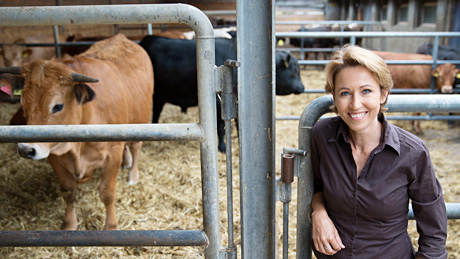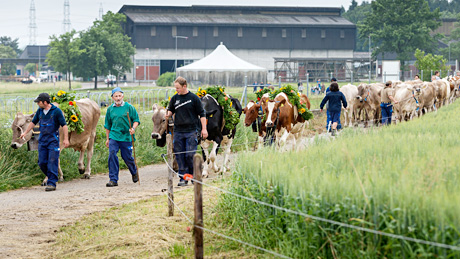Navigation auf uzh.ch
Navigation auf uzh.ch

Dr Soliva, in the middle of last year, the Cantonal Parliament of Zurich unanimously approved a loan of 29 million francs for the construction of the planned new buildings at Strickhof. The demolition of the old stables and the construction of the first of the new buildings will start in summer/autumn 2015. What do these construction projects entail?
Carla Soliva: The new buildings are split into two sub-projects. On the one hand, the Canton of Zurich is setting up a livestock centre. This consists of one building for dairy cattle and another for rearing and fattening calves and beef cattle. This will be beneficial for agricultural training, as well as teaching and research in veterinary medicine and agricultural sciences. The livestock centre will also include a ‘forum’ building for lectures and public events. Meanwhile, ETH Zurich is creating a metabolic centre with study pens for cattle, horses, pigs, poultry and rabbits, as well as respiration chambers. There will also be an office and laboratory building for researchers from ETH Zurich and the University of Zurich.
Will the new infrastructure open the door to new areas of research?
Soliva: The new infrastructure will allow us to examine the entire food value chain using the holistic ‘from feed to food’ approach, i.e. starting with animal feed production, then feeding, and all the way up to the provision of foodstuffs. The focus is on translational livestock research, which deals with various areas of interdisciplinary research, such as the call for livestock farming that is efficient, species-appropriate, local and low in emissions. The optimised infrastructure will increase the validity of studies in various ways; for one thing, it will be much easier to control environmental factors, such as external temperature, or the variable quality of meadows used by livestock. The new buildings will also offer researchers organisational and logistical advantages.
What will the new dairy cattle shed offer?
Soliva: The dairy cattle shed will include around 120 dairy stalls, one herd for the training of farmers, agricultural practitioners, animal keepers and students and one herd for research. Two different milking systems will also be installed, including a fully automated milking robot.

The metabolic centre will be the key element of the new construction. What new opportunities in livestock research will this ultra-modern facility offer?
Soliva: Feed has a huge influence on the health and productivity of livestock. The metabolic centre will allow research into the influence of feed on the methane emissions of ruminant animals, or the feed requirements of dairy cows after birth. Farmers stand to benefit from this research, and it will of course also benefit the animals themselves as well as consumers.
Dr Soliva, as the new research director of the Agrovet-Strickhof Teaching and Research Center, you are acting as an interface between three project partners, four locations, farmers, veterinarians, agronomists, researchers, and students as users, while presiding over an ongoing, multi-million-franc construction project. Can you briefly outline your main duties?
Soliva: I will be working on the construction of Agrovet-Strickhof through to its planned opening in 2017. The new centre will provide close links between agricultural science, veterinary medicine and agricultural practice (see box). In my role as scientific advisor, I will also be supporting the construction projects and the development of the operational and utilisation plans. At the same time, I will coordinate research activities in the area of livestock at Agrovet-Stickhof.
It is a complex task to organise, coordinate and communicate these matters, so I am glad I have been familiar with the Agrovet-Strickhof project for some years. I worked at both ETH Zurich and the Vetsuisse Faculty at the University of Zurich following my dissertation.

Dr Wettstein, you head ETH Zurich’s three existing agricultural research stations: Chamau, Früebüel and Alp Weissenstein. The latter two will form part of Agrovet-Strickhof in future; Chamau was sold to the Canton of Zug at the end of last year and has been leased by ETH Zurich since this time. The Chamau site will be discontinued when Agrovet-Strickhof opens in 2017. Why is that?
Hans-Rudolf Wettstein: ETH Zurich made a strategic solution to enter into close cooperation with Strickhof and the University of Zurich in order to strengthen the agricultural sciences. This cooperation has led to substantive and operational synergies. Strickhof already has a farm in the valley in Eschikon Lindau, and ETH Zurich already has a presence in Eschikon Lindau with its Research Station for Plant Sciences, thus the Chamau research station will be discontinued. However, the two sites in the mountains (Früebüel, 1,000 m above sea level) and the Alpine farm region (Alp Weissenstein, 2,000 m above sea level) will be integrated into Agrovet-Strickhof.
You will be moving to Eschikon Lindau as the new IT director once Agrovet-Strickhof opens. What duties do you believe await you there?
Wettstein: Many new systems will be integrated into the Agrovet-Strickhof site, which will be required to collect and store vast quantities of data. Just as an example, these systems will be used to automatically record quantities of feed in the livestock centre. The milking systems will also supply data on the quantity and quality of milk, among other things. On top of this, there will also be information on the origin of animals and analysis of the feed used. My primary task will be to develop concepts for how these data can be interconnected and exploited.